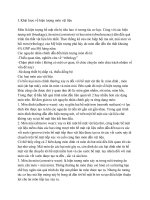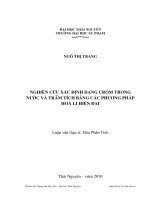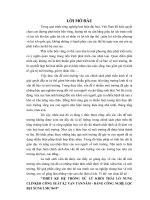Polymer processing li
Bạn đang xem bản rút gọn của tài liệu. Xem và tải ngay bản đầy đủ của tài liệu tại đây (2.6 MB, 22 trang )
Polymer Processing
Peng Li, Mar. 15th
Chapter 18
Manufacturing Engineering and Technology 4th Ed., S. Kalpakjian and S. R. Schmid
What Are Polymers?
Polymerization
Plastic Materials = Polymers
Long-chain molecules built up
from shorter molecules (mers)
with the spine of the molecules
usually comprised of carbon
atoms.
Polymer= …+ mer + mer + mer +…
Approx. 50 to 20,000 units
Types of Polymers
From a processing point of view, the main classes are:
Thermoplastic: the polymer is heated to make a viscous liquid and
then processed into a usable object without much additional
chemistry. Example: polyethylene, polystyrene.
Retain its plasticity.
Thermoset: upon heating, further reaction occurs to make
molecules “set up” into a useful product. Chemistry occurs, so these
are sometimes called “reactive polymers”. Example: polyurethanes,
phenol-formaldehyde, melamine-formaldehyde, epoxy glue.
Become permanently hard and brittle.
Polymer Processing
Start with coal and petroleum products, heat to
polymerize to make giant molecules.
The processing of polymers involves operations similar
to those used to form and shape metals, e.g. molding,
casting, forming, machining and joining.
They can be processed into many shapes with relative
ease (e.g. at lower temperatures and strengths) and in
few operations.
Want many forms: fibers, complex shaped parts, foams,
laminates - sheets, so need many different processes.
Also must deal with meltable and irreversible types.
Polymer Processing
Thermoplastic processes: Extrusion (also films
and tubes), fiber drawing, blow molding,
thermoforming, injection molding …
More for thermosets: casting, compression
molding, transfer molding …
Polymer Processing
Thermoplastic Processes – Extrusion
Complex shapes with constant cross-section can be
extruded with relatively inexpensive tooling.
internal friction +
Thermoplastic Processes – Extrusion
Sheet and Film Extrusion
Thermoplastic Processes – Extrusion
Tube Extrusion
Polymer
Air
Polymer
From />
Thermoplastic Processes – Extrusion
Blown Films → Wrapping films and Bags
Thermoplastic Processes – Fiber Drawing
Fiber drawing (E.g., nylon)
1) extrude molten resin
2) stretch and cool
3) pull through rolls
V2>V1
Thermoplastic Processes – Fiber Drawing
Heater (Optional)
Stretching Zone
Drive roll
Control
rolls
Snubbing
pin
ν2
(ν2 > ν1)
ν1
Skewed idler roll
Drawn yarn to
bobbin
Undrawn
pretwisted yarn
Redrawn by Nadia Edwin from Billmeyer 18-5 (Riley 1956)
Thermoplastic Processes – Blow Molding
A) Extrude parison
B) Close mold
C) Blow and cool
(parison thins as it stretches)
D) Eject
Thermoplastic Processes – Thermoforming
Thermoplastic Processes – Thermoforming
Thermoplastic Processes – Injection Molding
Thermoplastic Processes – Injection Molding
Insert molding - Metallic components, such
as screws, pins and strips, can also be
placed in the mold cavity and become an
integral part of the injection-molded product.
The most common examples of such
combinations are electrical components.
Thermoset Processes – Casting
e.g. encapsulating
electrical circuits,
unlimited geometry,
low production rate
Thermoset Processes – Compression molding
Typical parts made are dishes, handles, container caps,
fittings, electrical and electronic components, washingmachine agitators, and housings.
Flash-type, for shallow or flat parts
Positive, for high density parts
Semipositive, for quality production
Thermoset Processes – Transfer Molding
Combination of compression molding and injection molding.
Used for making electrical and electronic components.
Polymer Processing – Brief Review
Thanks for your patience.









